Did you know that 41% of home buyers start their search for the perfect property online?
As a real estate agent, you show off stunning homes, make sales, close deals, and win over clients primarily offline.
However, the surplus of real estate listing sites like Zillow and Realtor.com has outphased many in-person marketing techniques.
You know it’s time to give yourself a competitive edge in the digital real estate scene. But where do you even start?
In this guide, we’ll go over nine foolproof tips for crafting winning, client-converting real estate marketing content.
What Is Content Marketing in Real Estate?
Content marketing is the process of creating high-quality, valuable content that’s optimized for search.
The goal is to inform and provide value to potential clients and current clients.
Content marketing in real estate is any type of content that seeks to solve your potential and current clients’ pain points when it comes to real estate topics (such as home buying, loans, mortgages, the local area, etc.).
1. Create High-Quality Ultimate Guides to Local Areas.
As a real estate agent, you’re an expert in the area. While some of your clients likely already know their way around town, newcomers are burdened with researching the best neighborhoods, most convenient locations, safest areas, and more.
Nothing will attract these clients more than a realtor who alleviates this stress.
Aim to create the best, most in-depth guides to the local areas you serve. Think of all the questions your new-to-the-area clients have asked during their home hunting, then do your best to answer them concisely.
For example, check out this article on Forbes called “The Definitive Guide To Moving To Austin.”
It gives readers a to-do list for their first week in Austin, explains the competition for rental properties, the climate, the big festivals Austin is known for, and more.
To start creating your guide, combine your findings from keyword research and the most frequently asked questions of your previous and current client base.
Keyword research will show you what queries your target audience searches for on Google (i.e., the information they’re looking for). You can also generate ideas for your guides using a tool like AnswerThePublic.
For example, searching the term “move to San Diego” gives you these topic ideas:
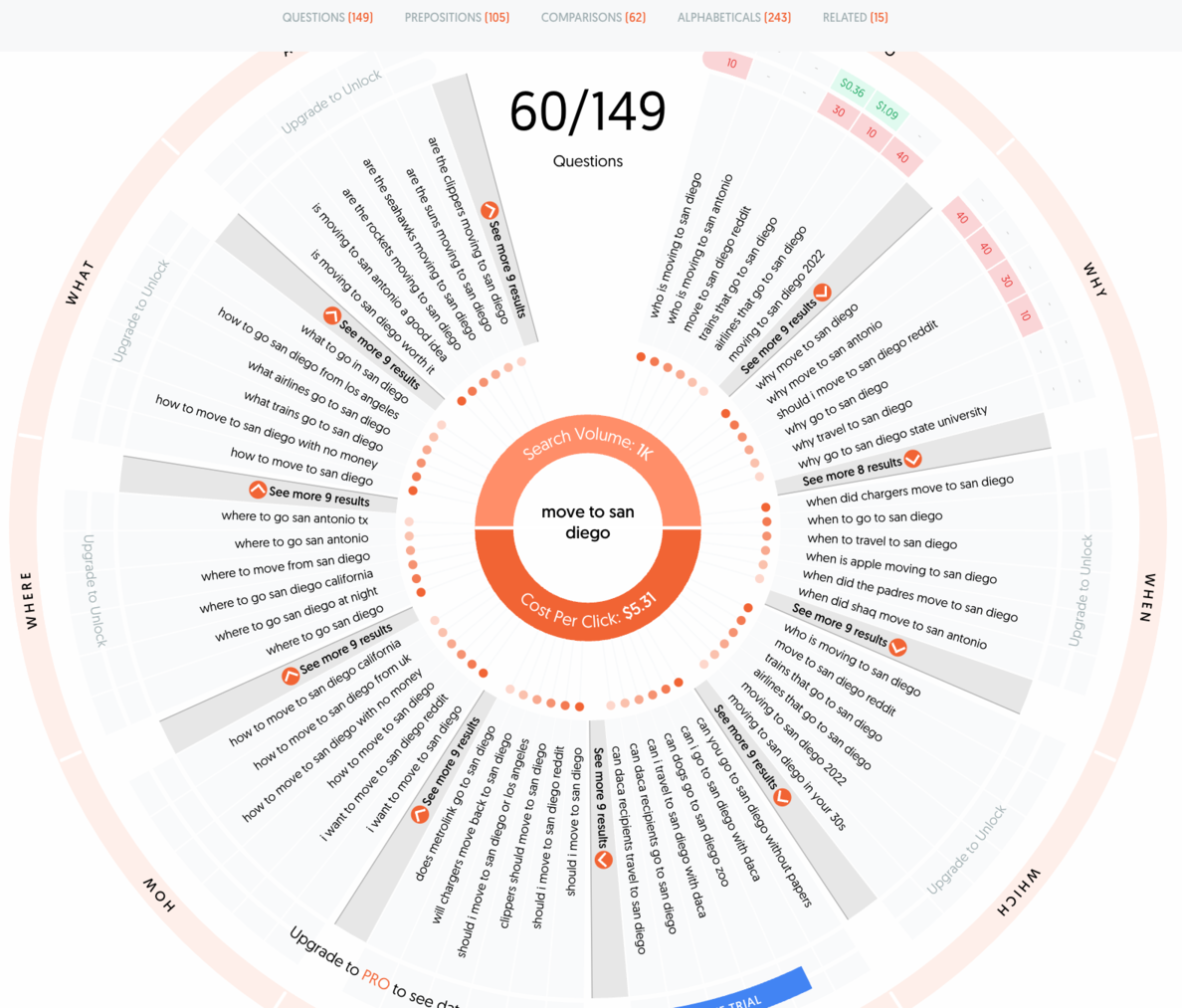
Targeting the right keywords gives your guides the best chance at ranking highly on Google search engine results pages. This brings more exposure, more search traffic, and, eventually, more new clients.
2. Post Round-ups of New Listings and The Best Deals.
A round-up is a list-form blog post that tells readers the best product, service, tip, etc. In the case of real estate, your round-ups would be lists of properties.
There are several ways you can display your listings on your website.
First, you can hire a web developer to create a custom solution on platforms like WordPress. This is usually a one-time fee and fully customized to your needs and creative ideas.
You can also invest in a subscription-based Turnkey commercial real estate platform. It’s not fully customizable like the first option, but it easily integrates with your site, and the setup time is much faster.
Finally, check if widgets are available for other sites you use to list your properties. For example, real estate agents who use Loopnet can download the LoopLink widget to show their listings on their website.
You can theme your round-ups to appeal to specific ideal clients. For example, you can create “best budget-friendly” round-ups, “safest neighborhood” round-ups, “most centrally-located” round-ups, etc.
3. Post Video House Tours to Social Media and Blog Posts.
Thanks to the internet, you can easily show off your best properties and capture the interest of potential buyers before you even meet them face-to-face.
Filming and photographing your properties is also a great way to stock up on valuable content for social media and blog posts that will continue bringing you leads.
There are several ways to show your listings virtually.
First, we have 3D tours. These are done with a specific type of camera. After the photos are taken, they’re uploaded to a software program that renders them in 3D to give a video-like appeal.
However, it’s worth noting that this type of photography is pretty costly. And with the rise of social media apps, many real estate agents are opting for the second option: filming video tours with any type of camera (even your iPhone).
The younger generation especially loves this type of real, raw footage instead of the cinematic production-looking 3D models.
After you’ve created your videos, squeeze everything you can get out of them by posting them to your social media profiles and YouTube channels. Once uploaded to YouTube, you can easily embed them into blog posts or pages on your real estate website.
Here are some examples of house tours on YouTube:
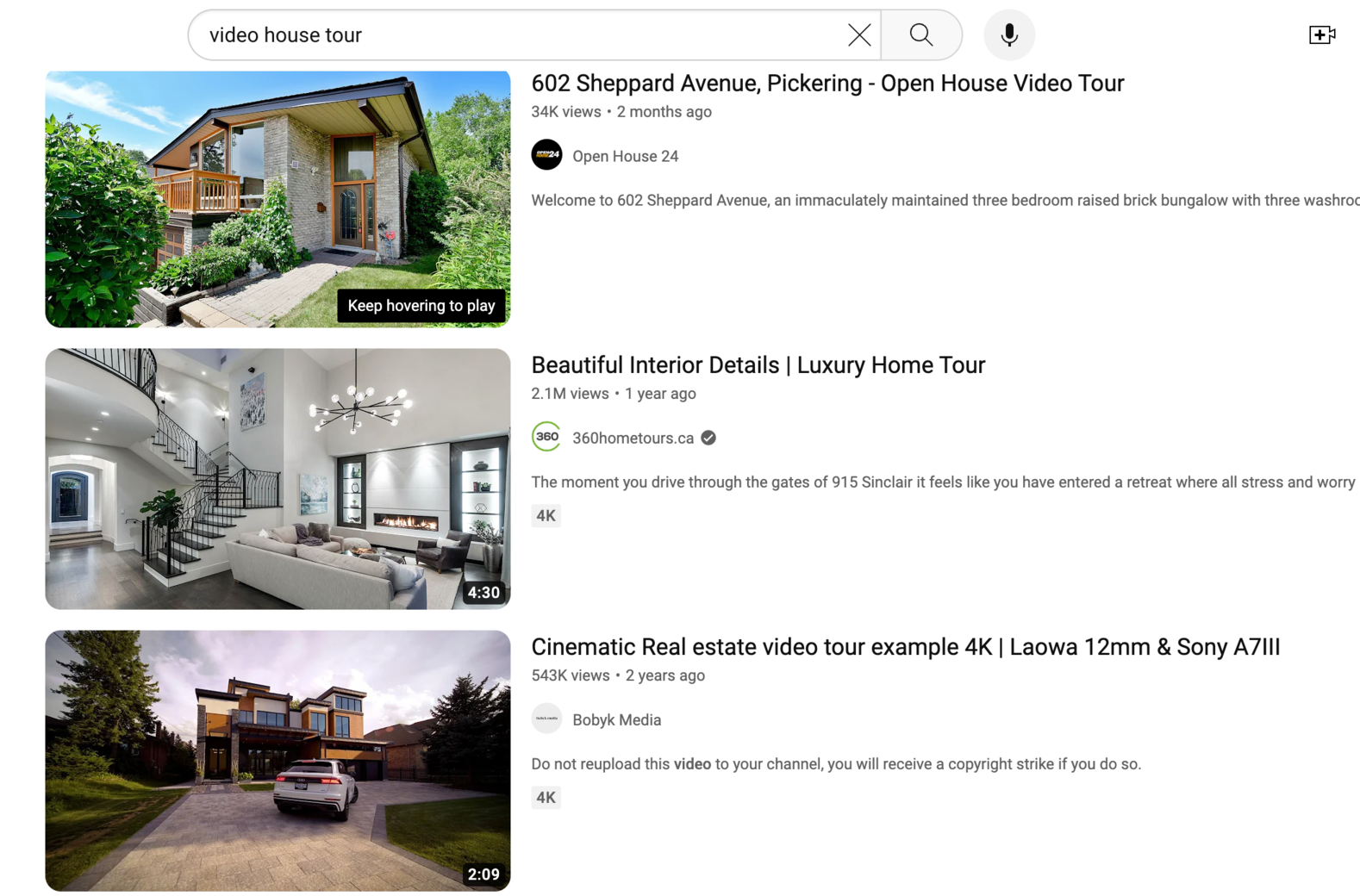
4. Position Yourself as a Local Celebrity.
A “local celebrity” refers to someone well-known in their area for a specific reason—a business owner, journalist, news anchor, social media influencer, restaurant reviewer on YouTube, etc.
As a realtor, local celebrity status should be something you strive to achieve. It brings you more leads due to increased brand awareness and positions you as the go-to expert for all things “Your City.”
Your ultimate guides are an excellent starting point. But you should also aim to stay active on social media by posting real estate content in different parts of town, using local hashtags, participating in online discussions, and more. You can do this on any platform—Facebook, Instagram, Twitter, LinkedIn, etc.
If you need ideas for content, here are some guaranteed ways to start off on the right foot:
- Where/what are the best restaurants?
- What are the best things to do?
- What are the upcoming family-friendly events of the year?
- What’s the town’s local history?
- Where are the hidden gems (i.e., places people don’t usually find until they’ve lived there and have the “inside scoop”)?
I also recommend taking advantage of local Facebook groups.
For example, Longview, Texas, has this insanely popular Facebook group called “All Things Longview.” The name says it all—people ask for advice, post memes, make friends, advertise their business, and more.
Just making comments offering expert advice on the area can quickly put you in the spotlight and position you as an industry authority.
Finally, you can collaborate with other local businesses and small celebrities in many ways.
For example, after your clients purchase one of your real estate listings, they’ll need furniture, electricity, internet, and cable. Scout out local businesses that offer these essentials and try to work out a partnership.
For instance, you can display your advertisements in their store windows, and in exchange, you bring them more customers by referring your clients to them. Many businesses also offer discount codes for referrals from their partners to encourage more sales.
All it takes is writing up a simple proposal and presenting it until you’ve found a mutually beneficial match.
5. Clear Up Confusing Topics Like Taxes, Mortgages, and Loans in SEO Blog Posts.
What are the topics that plague your ideal clients the most? Explain them as if you could do it in your sleep.
Aside from creating guides about the local area, you must also answer the questions that haunt some clients—namely, topics related to taxes, mortgages, loans, contracts, and other serious financial concepts.
To identify these topics and ensure your chances of ranking well for them are high, use a keyword research tool like Ahrefs, Mangools KWFinder, or SEMRush.
These tools show you the potential monthly search traffic, keyword difficulty, cost per click, and more.
You also get a list of related phrases you can target. Just look at the results SEMRush gives for the keyword “how to rent a house in Florida”:
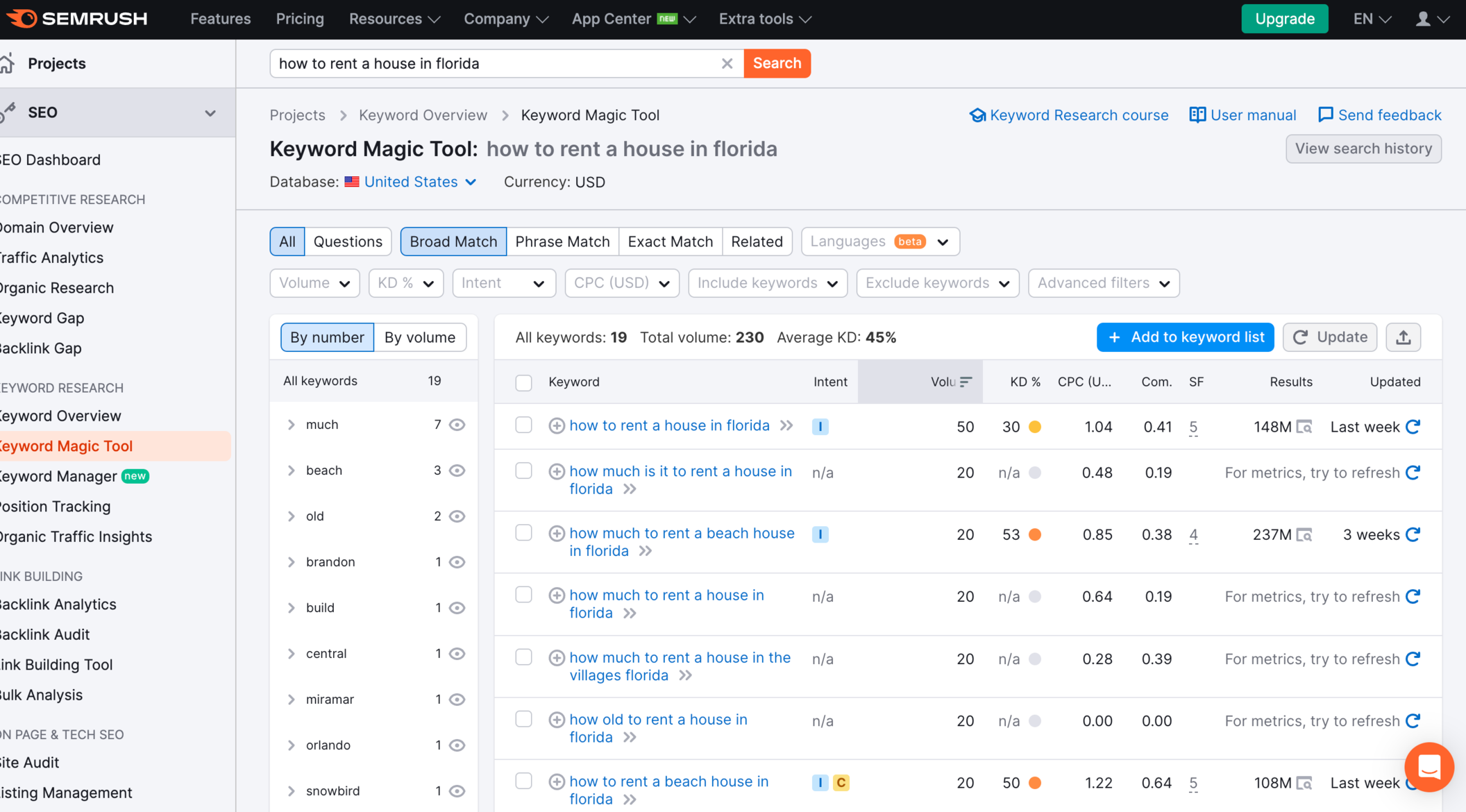
Once you’ve identified the keywords, do user intent research to determine what the people searching for them want to know.
Taking our “how to rent a house in Florida” example, you can see from the top Google search results and the “People also ask” box that most people searching for the phrase aren’t interested in renting a house to live in. Instead, they want to rent their house to others to make an income from it.
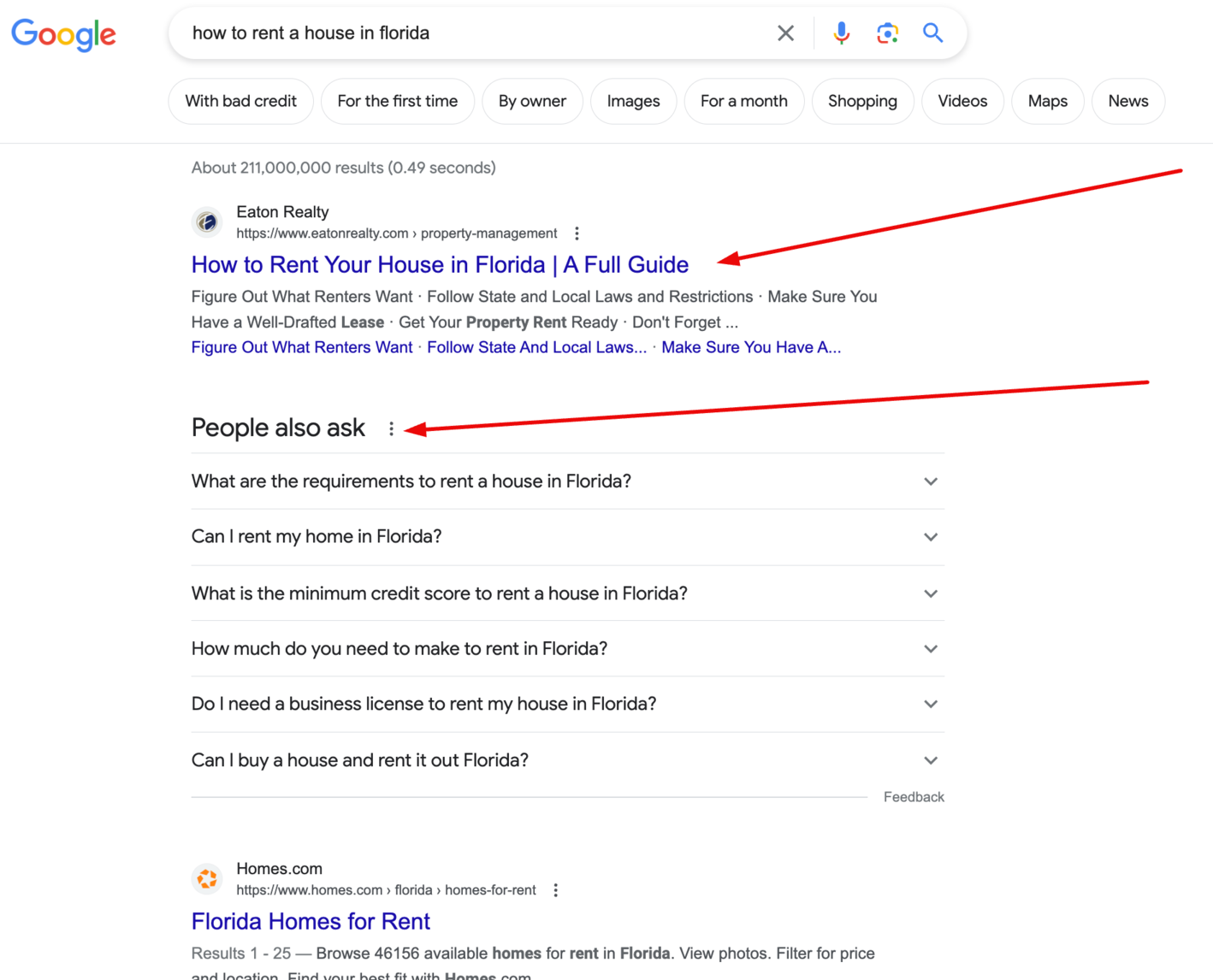
Finally, examine the competition and come up with something better. In other words, more in-depth, practical, and valuable.
6. Create Compelling Lead Magnets.
A lead magnet is something you offer for free in return for a lead’s contact information.
Lead magnets are powerful tools to generate a long-lasting pipeline of leads because they allow you to stay in direct contact with your ideal clients who have already expressed interest in your services.
For example, most lead capture forms ask for the visitor’s name and email address. Once they’ve submitted it, the lead magnet they signed up for (i.e., a free PDF download or ebook) is delivered to their inbox, and they’re automatically subscribed to your email list (which is great if you run a newsletter).
This means you can continue to email them, providing more value and answering more questions until they eventually become a client.
Creating a lead magnet is simple. Take one of the topics you’ve identified in the previous steps and create a valuable, comprehensible resource that your ideal clients would want.
You can even convert your existing content into a lead magnet by making it more long-form or turning it into other forms.
For example, your ultimate guide blog post to Tampa, Florida, can be turned into a free one-hour video crash course on everything aspiring Florida homeowners need to know about property tax and interest rates in the state.
Once you’ve created your lead, you’ll need a lead capture form. This is the form site visitors fill out to get access to your lead. You can easily create one using free email marketing platforms like Mailchimp and Convertkit.
7. Create Instagram Highlights and Blog Post Tags for Neighborhoods and Testimonials.
Shifting gears into social media marketing, you need to start thinking of your Instagram as a portfolio.
There are limitless creative options on Instagram—from reels to IGTV, to pinned posts, to stories, and more.
But one of the most underrated Instagram features is the story highlights people can see on your profile.
Although your Instagram stories expire after 24 hours, saving them to a story highlight keeps them on your profile forever. You can create as many highlights as you want and name them however you please. But in this case, you’ll need to name them after the locations you sell properties in.
For example, take a look at San Antonio realtor @Ryder_Realtor’s Instagram highlights:
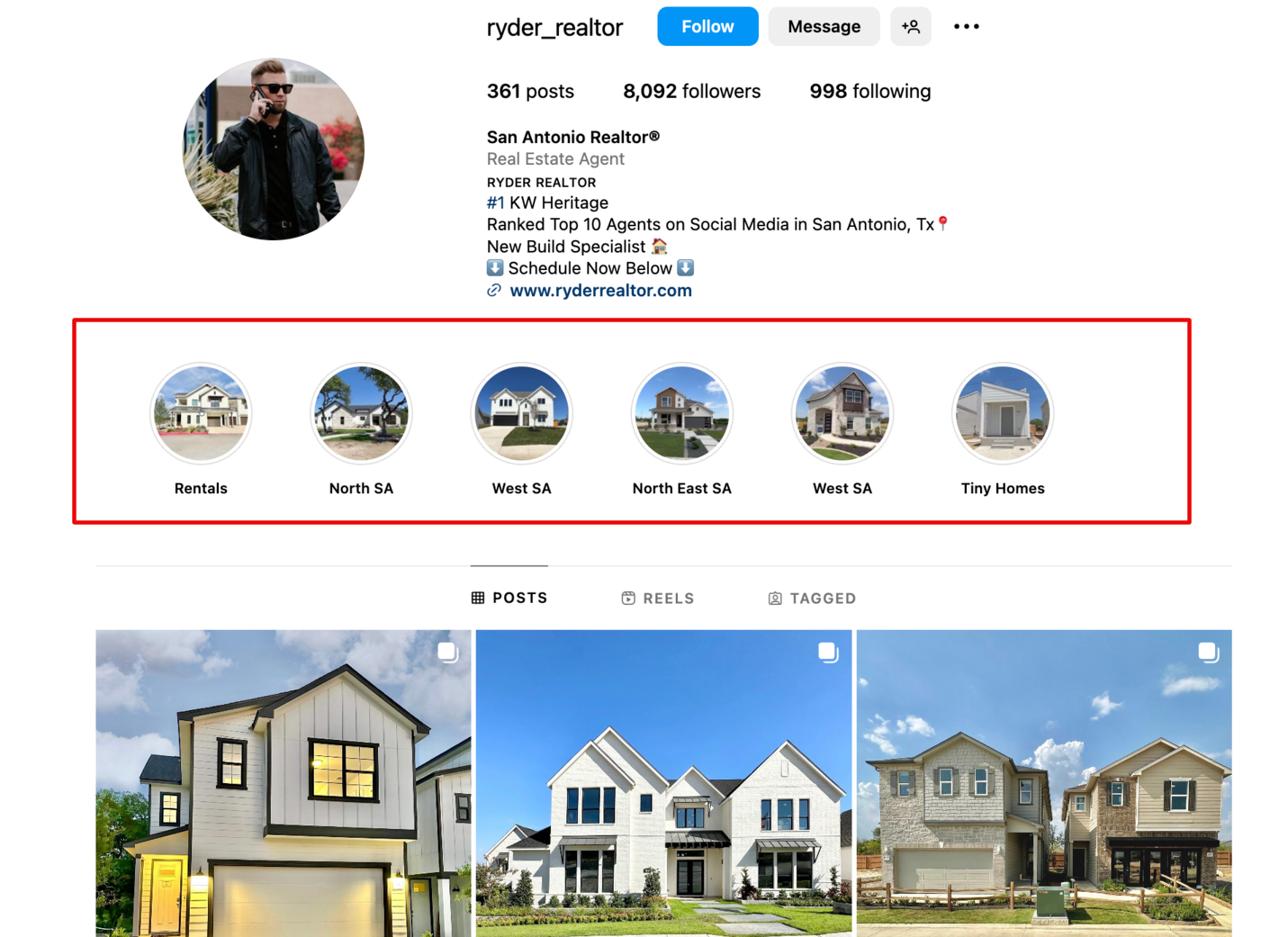
When uploading photos of homes, rental properties, deals, or even things to do in specific neighborhoods, save these stories to the appropriate highlight. That way, new (and existing) followers can see everything you offer in one place.
You can even create a free QR code that leads to your listings page. Post a picture of it to your highlights, and then it’s a no-brainer for your interested followers to access the page.
You can do something similar with blog posts using tags.
For example, after publishing your ultimate guide to Tampa, Florida, you can tag it as “Tampa, Florida.” When site visitors click on this tag, they’ll see all the articles you’ve written related to Tampa.
You can also take screenshots of your client testimonials and add them to a highlight.
8. Take Advantage of Automation Software Available for Marketers
Marketing automation software makes managing your marketing processes simple and centralizes them in one place, even if you use multiple channels. The goal is to streamline your digital marketing as much as possible.
For example, most marketing automation software lets you manage your email marketing, social media marketing, SMS marketing, and more from one technology.
As such, it can save you time, money, and stress when creating high-quality content in mass as a real estate agent.
Plus, marketers who invest in marketing automation see a 451% increase in qualified leads on average.
One platform that manages your content creation efforts—and with realtors specifically in mind—is Xara.
Xara is a complete toolkit that supports your content strategy initiatives from start to finish. With Xara, you can:
- Create and manage branded content with your automatically added logos and company themes.
- Unify your marketing workflows and have a centralized location for everything your content creation, marketing, and sales teams need.
- Upload your ideas in document form to have them transformed into high-quality designs ready to publish in your blog posts, social posts, and other forms of content.
- And more
9. Write Guest Posts for Local Publications
Although local newspapers and blogs aren’t as popular as they once were, a handful of people still use them to find the best deals in the area.
You can leverage this by taking your content creation efforts outside your own website and contributing to others. This brings more exposure to your site, spreads your name, and generates leads.
You can easily identify your city’s newspapers in the local library and newspaper directories like 50states.com and Onlinenewspapers.com.
Reach out to the appropriate person—usually an editor or Chief Editor—and pitch your ideas.
Lead-generating Real Estate Marketing Content Is About Providing Value.
Like many industries, the real estate industry is facing a more competitive climate than ever.
With the presence of social media, the convenience of a Google search, and the normalized digital lifestyle brought to us by 2020, there’s no denying that you need to level up your content marketing strategy if you want to keep a competitive edge.
With these nine tips, not only will you future-proof your real estate business, but you’ll also better serve your clients in an ever-changing world.
Try Xara’s Marketing Center For Realtors Today for Free!
Get Your Free Real Estate Marketing Materials For Your Business!
Join 10 000+ real estate agents powered by Xara Marketing Center.
- Sign up for a free account.
- Get a 14-day premium trial.
- No credit card required.





 No credit card or phone number required.
No credit card or phone number required.